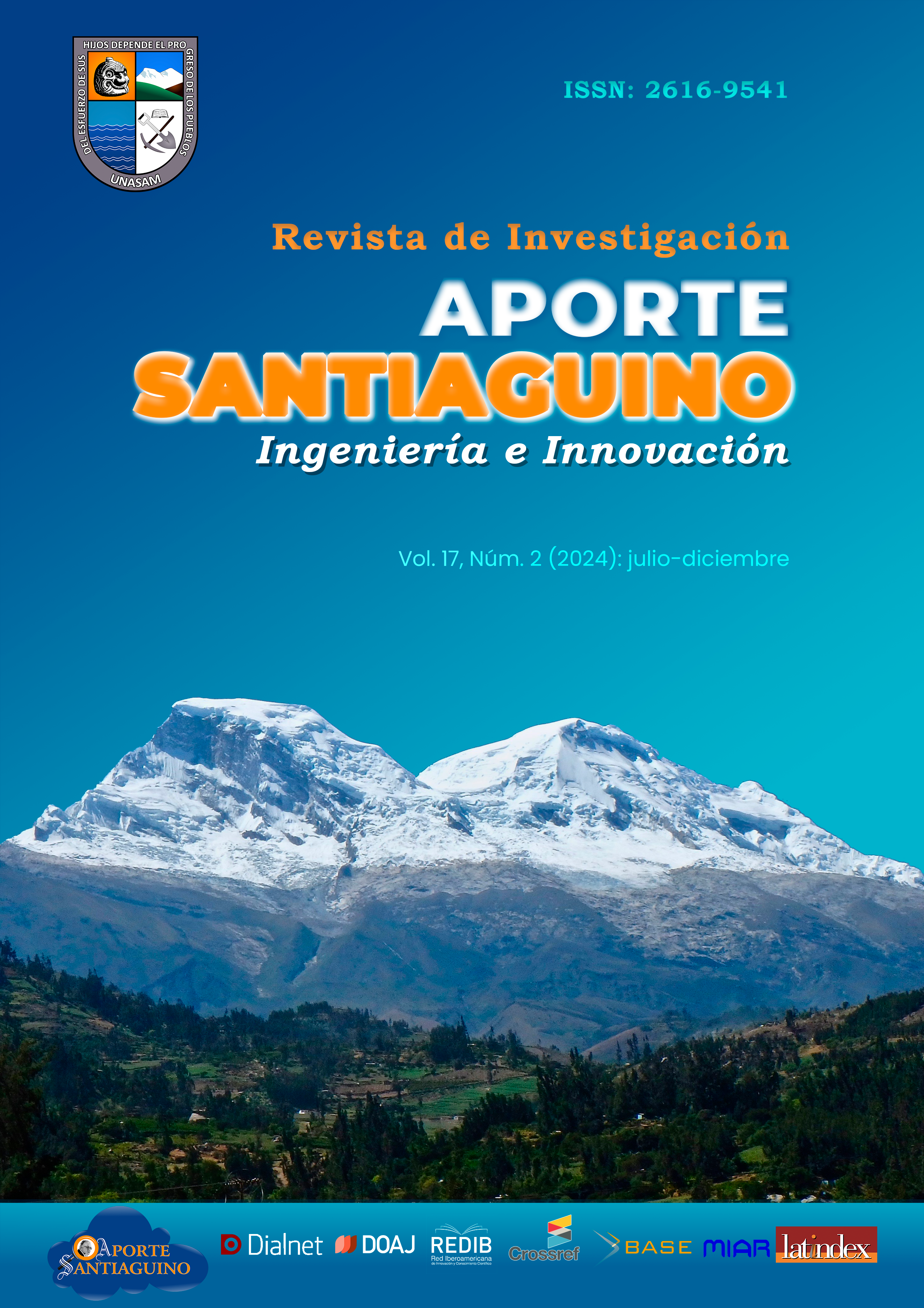Behavior of adobe walls with seismic isolation using shicras subjected to monotonic lateral load
DOI:
https://doi.org/10.32911/as.2024.v17.n2.1191Keywords:
Shicras, Seismic isolation, Monotonic loadingAbstract
Due to limited economic resources and easy access to soil as a building material, rural dwellers often build their homes with adobes, without applying anti-seismic design techniques or standards. This makes these homes highly vulnerable to earthquakes. In this context, the present research aimed to evaluate the behavior of adobe walls with seismic isolation through the use of shicras under monotonic lateral loading. To do this, the anti-seismic construction technique used by the Caral civilization was applied. Four treatments were designed: T0 (conventional overhang), T1 (overhang of shicras with 5-inch stones), T2 (overhang of shicras with 3-inch stones) and T3 (overhang of shicras with 1-inch stones) with three replications for each treatment. The field tests showed that walls 7, 8 and 9, corresponding to the T2 treatment, achieved the highest maximum displacements, with values of 12.83 mm, 12.12 mm and 13.09 mm in walls 7, 8 and 9, respectively. In addition, these walls withstood maximum lateral loads of 13.43 kN, 13.92 kN and 12.94 kN. The foundations built with stones wrapped in shicras acted as a roller-type insulation, providing rigidity in the vertical plane and flexibility in the horizontal.
Downloads
References
Agüero, J., Cerón, J., Gonzales, J. & Méndez, M. (2015, 9-13 de noviembre). Análisis estructural de dos muros de adobe con diferentes sistemas de aparejo. Seminario Iberoamericano de Arquitectura y Construcción con Tierra, Ecuador. https://dialnet.unirioja.es/descarga/articulo/6085978.pdf
Aguilar, L., Guzmán, L., & Sauñi, C. (2019). Efecto sísmico de aplicación de Shicras en muros de adobe en zonas altoandinas de la provincia de Concepción - Junín. https://acortar.link/tzGnXO
Altamirano, A. J., & Bueno, A. (2011). El Ayni y la Minka: dos formas colectivas de trabajo de las sociedades pre-Chavín. Investigaciones Sociales, 15(27), 43-75. http://dx.doi.org/10.15381/is.v15i27.7659
Barbachán, E. A., Barbachán, M. A., Cáceres, J. J., Ruiz, C. N., & Casas, E. R. (2022). Soluciones tecnológicas ancestrales y su aplicación en tiempos actuales. Universidad y Sociedad, 14(S1), 476-486. https://rus.ucf.edu.cu/index.php/rus/article/view/2658
Blondet, M., Vargas, J., Tarque, N., & Iwaki, C. (2011). Construcción sismorresistente en tierra: la gran experiencia contemporánea de la Pontificia Universidad Católica del Perú. Informes de la Construcción, 63(523), 41-50. https://doi.org/10.3989/ic.10.017
Calderón, A. D. (2005). Modelación inelástica de mampostería confinada ante carga lateral [Proyecto de Grado, Universidad de los Andes]. https://repositorio.uniandes.edu.co/bitstream/handle/1992/22704/u270997.pdf?sequence=1
Clarke, N. (2015). Revolutionizing the Tragic City: Rebuilding Chimbote, Peru, after the 1970 Earthquake [Revolucionando la ciudad trágica: reconstruyendo Chimbote, Perú, después del terremoto de 1970]. Journal of Urban History, 41(1), 93-115. https://doi.org/10.1177/0096144214552392
Eslami, A., Mirabi, H., & Ronaghb, H. (2022). Sand-coated reeds as an innovative reinforcement for improving the in-plane seismic behavior of adobe walls [Carrizos recubiertos de arena como refuerzo innovador para mejorar el comportamiento sísmico en el plano de muros de adobe]. Construction and Building Materials, 326, 126882. https://doi.org/10.1016/j.conbuildmat.2022.126882
Fukuyama, H., Fujisawa, M., Abe, A., Kabeyasawa, T., Shirane, Z., Saito, T., & Aguilar, Z. (2013). Shaking Table Test on Seismic Response Properties of “Shicras,” Stones Wrapped in Vegetable Fiber Bags [Prueba de mesa vibratoria sobre las propiedades de respuesta sísmica de las “shicras”, piedras envueltas en bolsas de fibra vegetal]. Journal of Disaster Research, 8(3), 526-533. https://doi.org/10.20965/jdr.2013.p0526
Fukuyama, H., Fujisawa, M., Abe, A., Kabeyasawa, T., & Shirane Z. (2016). Research on earthquake response reduction properties and its repeatability of the foundation technology used in the sanctuaries dating up to 5,000 years ago [Investigación sobre las propiedades de reducción de la respuesta a terremotos y su repetibilidad de la tecnología de cimentación utilizada en los santuarios que datan de hace 5.000 años]. Journal of Japan Association for Earthquake Engineering, 16(11), 11-25. https://doi.org/10.5610/jaee.16.11_11
Gama, J., Tamara, C., Pi-Puig, T., Alcalá, R., Cabadas H., Jasso, C., Díaz, J., Sánchez, S., López, F., & Vilanova, A. (2012). Arquitectura de tierra: el adobe como material de construcción en la época prehispánica. Boletín de la Sociedad Geológica Mexicana, 64(2), 177-178.
Meybodian, H., Eslami, A., & Morshed, R. (2020). Sustainable lateral strengthening of traditional adobe walls using natural reinforcements [Fortalecimiento lateral sostenible de muros tradicionales de adobe mediante refuerzos naturales]. Construction and Building Materials, 260, 119892. https://doi.org/10.1016/j.conbuildmat.2020.119892
Reglamento Nacional de Edificaciones (2022). Norma E.080 de Diseño y construcción con tierra reforzada (16 ed.). Megabyte.
Sánchez, C., Alonso, E. M., & López, M. C. (2021). Vulnerabilidad sísmica y la pérdida de la vivienda de adobe en Jojutla, Morelos, México, tras los sismos de 2017. Viviendas y Comunidades Sustentables, (10), 9-29. https://doi.org/10.32870/rvcs.v2i10.162
Salazar, J. A. (2022). Huaraz a 52 años del terremoto de 1970: lecciones no aprendidas. Enfermedades y Desastres Sociales, 14(1), 1-23. http://dx.doi.org/10.21142/des-1401-2022-0006
Zhang, L., Zhou, T., Zhang, Z., Tan, W., & Liang, Z. (2022). Near-surface-mounted retrofitting of adobe walls using different materials: Evaluation of seismic performance [Reforzamiento cercano a la superficie de muros de adobe utilizando diferentes materiales: Evaluación del desempeño sísmico]. Structures, 54(137), 1149-1163. https://doi.org/10.1016/j.istruc.2023.05.137
Zhang, J., Pang, S., Gao, J., Deng, E., Wang, H., & Zhao, J. (2020). Experimental study on seismic behaviour of adobe wall reinforced with cold–formed thin–walled Steel [Estudio experimental sobre el comportamiento sísmico de un muro de adobe reforzado con acero de paredes delgadas conformado en frío]. Thin-Walled Structures, 147, 106493. https://doi.org/10.1016/j.tws.2019.106493
Downloads
Published
How to Cite
Issue
Section
License
Copyright (c) 2025 Gerardo Revelo Sánchez, Fidel Aparicio Roque, Fernando Arias Enriquez, Atilio López Carranza, Flor Jara Remigio

This work is licensed under a Creative Commons Attribution 4.0 International License.




















